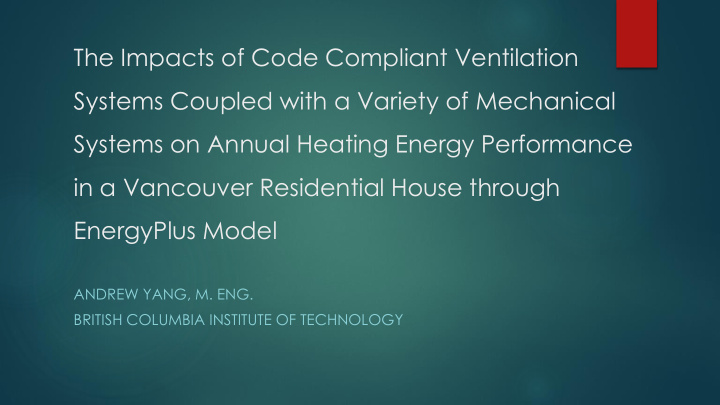



The Impacts of Code Compliant Ventilation Systems Coupled with a Variety of Mechanical Systems on Annual Heating Energy Performance in a Vancouver Residential House through EnergyPlus Model ANDREW YANG, M. ENG. BRITISH COLUMBIA INSTITUTE OF TECHNOLOGY
Introduction Change in BC Building Code Stringent building envelope requirement Importance of quality ventilation Dwelling Types in Canada Energy Use by Sector End-Use Energy Consumption
Objectives To study acceptable ventilation system’s heating energy use To analyze heating energy use for different systems through energy model To identify energy saving potential and potential improvements
House Specifications 2-Storey and a basement Area / volume: 2,388 ft 2 / 20,872 ft 3 Window-to-wall ratio: 9% Windows: 0.35 U-Value & 0.32 SHGC Air leakage rate: 2.5 ACH 50 Ventilation rate: 60 cfm
Type of Systems Investigated Electric Baseboard (Exhaust-only ventilation) Electric Baseboard (Balanced ventilation) Electric Baseboard (with HRV) Furnace Furnace (with HRV)
Type of Systems Investigated Electric Baseboard (Exhaust-only ventilation) Electric Baseboard (Balanced ventilation) Electric Baseboard (with HRV) Furnace Furnace (with HRV)
Type of Systems Investigated Electric Baseboard (Exhaust-only ventilation) Electric Baseboard (Balanced ventilation) Electric Baseboard (with HRV) Furnace Furnace (with HRV)
Type of Systems Investigated Electric Baseboard (Exhaust-only ventilation) Electric Baseboard (Balanced ventilation) Electric Baseboard (with HRV) Furnace Furnace (with HRV)
Type of Systems Investigated Electric Baseboard (Exhaust-only ventilation) Electric Baseboard (Balanced ventilation) Electric Baseboard (with HRV) Furnace Furnace (with HRV)
Heat Recovery Ventilator Exhaust Fan Supply Fan Heat Exchanger Core Transfers Heat from Exhaust Air to Fresh Air
System Specifications Design Heating Load Base Systems Design Heating Load Ventilation Load Without HRV 25,420 Btu/h 2,611 Btu/h With HRV 23,540 Btu/h 731 Btu/h Equipment sizing based on the design heating load Equipment Specifications Electric Baseboard Meets zone level loads Furnace 2.5 Ton (30,000 Btu/h) / 800 cfm HRV 79 cfm / 72% sensible efficiency
Simulation Results Annual Heating Energy Consumption [in kBtu] 40000 37,991 36,679 36,507 +475 kWh 35000 Fan Energy +51 kWh +408 kWh 30,141 30000 27,498 1,285 kWh 1,760 kWh 10,699 kWh 10,750 kWh 8,059 kWh 25000 35.5 GJ 25.5 GJ 20000 -3,099 kWh Heating Energy -10 GJ 15000 Baseboard Exhaust Baseboard Baseboard HRV Furnace Furnace with HRV Balanced Ventilation
Simulation Results Ave. Outdoor Air Temperature Avg. Indoor Air Temperature [ ° C] [ ° C] 82.00 85 Furnace (with HRV) 80.00 Baseboard (with HRV) 80 78.00 Furnace 75 Baseboard (Balanced) 76.00 70 Baseboard (Exhaust) 74.00 65 72.00 60 70.00 55 68.00 50 May Jun Jul Aug Sep May Jun Jul Aug Sep
Simulation Results
Conclusion HRV saved about 28% for the hypothetical house Saving percentage is closely related to envelope performance Summer overheating phenomena to be addressed Mechanical design to avoid unnecessary blower fan continuously running
Thank you
Recommend
More recommend